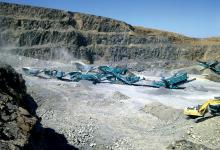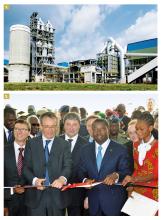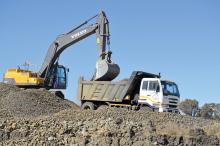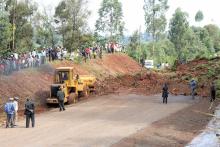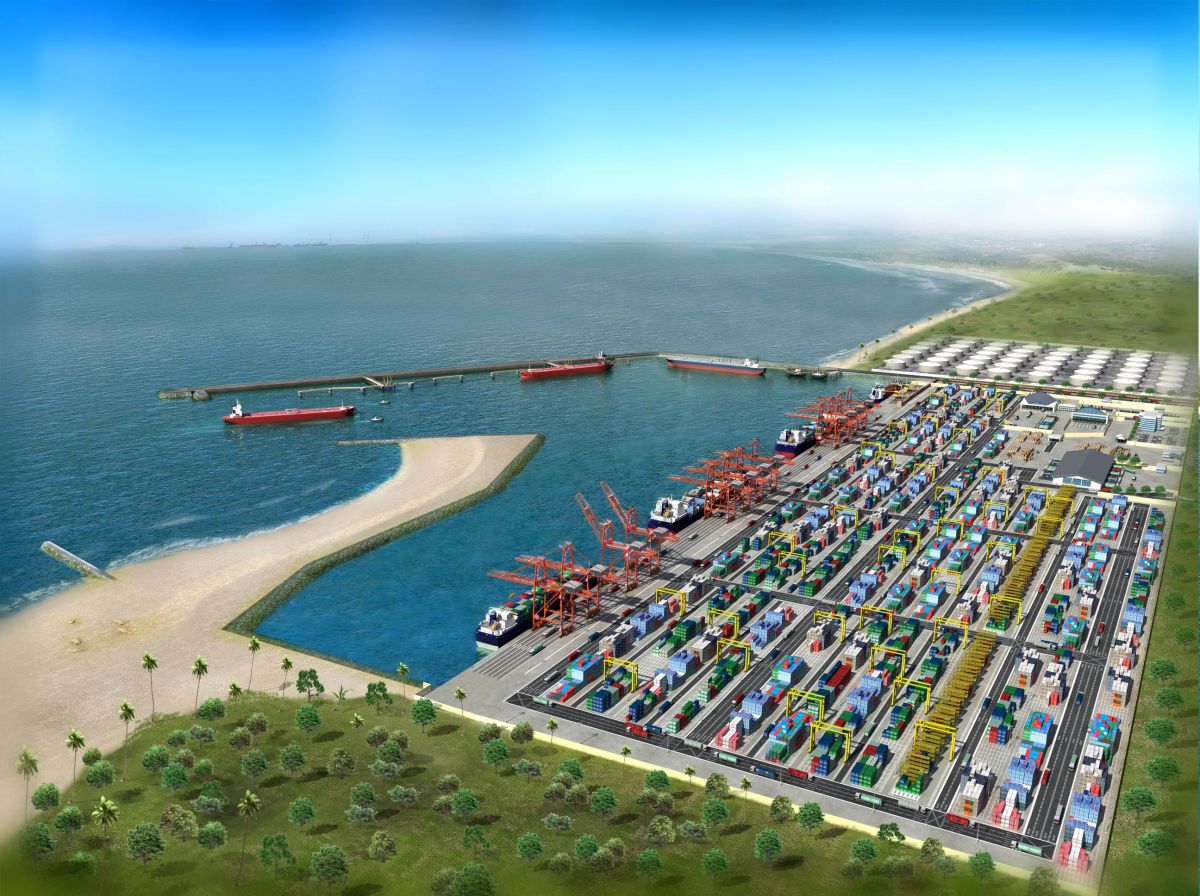
According to consultancy firm Deloitte, 32.2% of the West African region’s 286 infrastructure projects had broken ground in Sub-Saharan Africa by June 1, 2016. It said the region’s projects were worth $120 billion of Sub-Saharan Africa’s collective projects’ value of $324 billion. Nigeria, with 38, has the largest share of West African infrastructure projects, according to Deloitte.
Construction of Lagos Free Trade Zone port, Calabar-Katsina-Ala superhighway, Onne Port Complex, Olokola deepwater port, Centenary City, Eko Atlantic City and many mining projects are some of the investments that have put West Africa in top position in terms of the greatest value of projects underway in Sub-Saharan Africa.
Ebenezer Ibeneme of the professional services firm KPMG told Aggregates Business International in an e-mail response that the rapid urbanisation, growing economies and booming property market in West Africa have brought about an increase in the demand for construction materials, such as sand, gravel, crushed stones and cement.
“The response of the West African mining industry to this increased demand for construction aggregates, such as gravel and sand, over the last decade has been encouraging, with countries such as Gambia and Nigeria increasing sand production significantly over the last 10 years,” says Ibeneme.
Ibeneme says the response of the mining industry to the increasing demand in construction materials is “quite impressive”, adding: “Effective regulations and increased local and foreign investment are driving production to meet this demand.”
According to Ibeneme, the high cost of mining in developed countries has forced major global companies to seek investment opportunities in Africa, which offers relatively lower costs of production.
“Foreign investors are seeking expansion to new markets especially in the developing world, which presents a new investment frontier for leading international companies and the African mining industry is offering unparalleled opportunities,” adds Ibeneme.
"International companies, such as LafargeHolcim, BHP Billiton, Glencore, Sable Mining Africa Limited and Taurus Gold Limited have invested billions of dollars in the West African mining and aggregates industry over the last decade with mining licences in the region being held by mostly international companies,” he adds.
Ibeneme observes that “China has had a major influence in the mining sector in Africa, not just as a buyer of Africa’s resources, but also as a miner on the continent, with more West African governments increasingly demanding more from Chinese investors, such as requiring that minerals be processed locally before being shipped to China.”
Meanwhile, a survey of West Africa’s mining industry by Ecobank says Nigeria, Senegal and Ghana are the largest cement markets and continue to show “potential for growth” as more and more international companies scale operations in the market.
A report accompanying the survey says that between 2012 and 2014 “Nigeria emerged as the continent’s indisputable giant, with total capacity of 28.3 million tonnes/year, around a quarter of Sub-Saharan cement production capacity.” Demand for cement in the country, which consumed an estimated 18.3 million tonnes by 2013, is projected to grow to 35 million tonnes by 2020.
Ecobank says Nigeria, which is home to Africa’s largest cement maker, Dangote Group, has reported a sharp decline in cement imports, from an estimated $500 million worth of cement imports to around $139 million in 2012.
“This reflects the steady tightening of both the country’s import regimes, where the government is phasing out licences to import cement and encouraging investment in local production,” Ecobank states.
However, with a production capacity of 10 million tonnes/year, Ecobank warns Nigeria of the risk of overcapacity “following the wave of investments in new plants over the next five years”.
The company’s report states: “Nigeria’s production capacity is higher than the country’s consumption and this surplus is likely to surge over the next two years in line with Dangote’s expansion plans.”
Senegal and Togo are also key cement producers and exporters in West Africa, with the 2014 Ecobank survey saying they had a capacity of 6.7 million and 6.5 million tonnes/year respectively.
Dangote Group is now targeting 55 million tonnes/year of integrated grinding and import capacity in several countries. The company founder and president, Aliko Dangote, announced in early 2014 that the cement manufacturer was investing $4.7 billion in up to 18 countries in Africa.
Dangote commands 68% of Nigeria’s cement market share. Its three cement manufacturing plants boast a collective capacity of 29.25 million tonnes and include Obajana cement factory, Africa’s largest with a capacity of 13.25 million tonnes.
“Dangote’s strategy is to establish itself in Africa’s underdeveloped markets before its multinational rivals, drawing on its financial firepower and manageable debt levels, in order to capture high cement prices before a potential glut sets in,” says Ecobank.
Some of Dangote’s projects in West Africa in the last two years include a new 1.5 million tonnes/year integrated plant in Senegal, where France’s Vicat subsidiary Sococim is the market leader with 65% of the market. Ciments Du Sahel holds the other 35% share.
Dangote is also establishing a 1.5 million tonnes/year integrated plant in Cote d’Ivoire which is said to be targeting clinker from Nigeria and Senegal as feedstock. The company has also built a 700,000 tonnes/year import terminal in Sierra Leone.
In neighbouring Cameroon, where an estimated 1.6 million tonnes of cement are consumed annually, Dangote has invested in a 1.5 million tonnes/year grinding plant to supply the markets of Chad, Central Africa Republic and Gabon.
Ecobank says: “Dangote’s strategy of scaling up production of clinker at integrated plants served by plentiful limestone resources, exporting this to new grinding facilities in under-served markets such as Cameroon and Cote d’Ivoire and then exporting surplus cement to landlocked countries, will allow the company to build a dominating market share in under-supplied markets as well as help unleash latent demand in these countries.”
France’s Lafarge, now LafargeHolcim, and Germany’s
HeidelbergCement, on the other hand, being the largest market player in Ghana with its subsidiary, Ghacem, having a production capacity of 3.6 million tonnes/year, was expanding its Takoradi plant from 800,000tonnes/year to 1.4 million tonnes/year.
This would raise HeidelbergCement’s total capacity to 4.4 million tonnes/year. The German cement maker owns a 1.5 million tonnes/year clinker plant in Togo in addition to a 200,000 tonnes/year grinding plant. It is planning a 600,000tonnes/year grinding plant in Burkina Faso, a net cement importer.
KPMG’s Grace Olotu says trends in West Africa’s mining and aggregates industry would be dictated by performance of the construction sector, which is also growing at a rapid rate.
“Foreign investments, rapid urbanisation, developing industries and economics and other internal and external factors have fueled the increasing demand and supply in the region’s construction industry,” says Olotu.
Although there is a lack of reliable data on West Africa’s aggregate production capacity and it is, therefore, difficult to determine whether the demands of the industry are being met, Olotu says it is clear there is “a continued outward look by the mining and aggregate industry, as it is mostly export-oriented”.
However, she says West Africa’s burgeoning market faces the challenge of “country-specific political risk, as well as the finance required to establish a quarry business and other administrative bottlenecks.”
There have been some commendable changes promoted by governments in the region, such as, Olotu states, “providing regulatory incentives to attract foreign investors.”
In Ghana for example, the government has allowed mining companies to pay tax at a lower rate as well as claim capital allowances at a higher rate than other companies do.
Olotu cites the example of Nigeria where the government offers a pioneer status tax incentive to further attract international companies to invest in its mining sector. This includes exemption from customs and import duties in respect of plant, machinery equipment and accessories imported exclusively for mining operations, and accelerated capital allowance on mining expenditure.
In Burkina Faso, Olotu observes that the country’s fiscal regime provides a number of guarantees and tax allowances, such as right of ownership, freedom of management, exemption from customs duties on temporary imported equipment and a variety of tax reliefs, including accelerated depreciation.
Olotu concludes: “The [mining and quarrying industry] regulatory framework in West Africa is definitely improving in recent times, helping attract more investment from foreign governments as well as international companies.”

